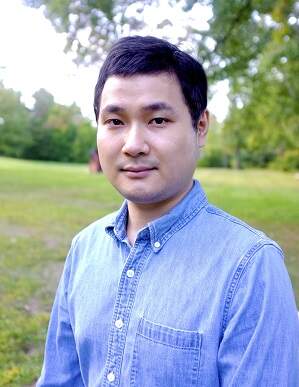
Longwen Huang, Ph.D, Prof.
-
Principal Investigator
State Key Laboratory of Brain & Cognitive Sciences, Institute of Biophysics
Research Interests: high-throughput connectome mapping, neural circuits underlying ethological behaviors, anxiety disorders
Email: huanglongwen@ibp.ac.cn
Tel:
Address: 15 Datun Road, Chaoyang District, Beijing, 100101, China
Chinese personal homepage
- Biography
2006 - 2010 Peking University, B.S. in Biological Sciences
2010 - 2015 Baylor College of Medicine, USA, Ph.D. in Neuroscience
2016 - 2021 Cold Spring Harbor Laboratory, USA, Postdoctoral Fellow
2021 - Institute of Biophysics, Chinese Academy of Sciences, Principal Investigator
- Awards
- Membership in Academies & Societies
- Research Interests
Ethological behaviors, including defensive behaviors, hunting behaviors, and social behaviors, are essential to survival and reproduction of animals. Understanding neural mechanisms that underlie ethological behaviors will not only provide valuable insights into the general principles of neural circuits and animal behaviors, but also facilitate the discovery of therapies for a variety of mental disorders, such as anxiety and depression. We mostly study mice, and exploit cutting-edge modern neuroscience techniques to elucidate neural mechanisms underlying ethological behaviors at the molecular, cellular, circuit, and behavioral levels.
1. High-throughput connectome mapping
Structure determines function. In the nervous system, connectivity patterns between neurons and brain areas determine how information is transmitted and processed in neural circuits to modulate and execute behaviors. Thus, high-quality connectivity maps are essential to systems neuroscience. We leverage DNA barcoding and high-throughput sequencing to convert the problem of connectivity mapping into a problem of DNA sequencing, and are able to determine brain-wide connectome in high throughput, at low cost, and at single cell resolution (BRICseq). Combining our methods with single cell RNA sequencing, we aim to determine single-cell projectome and transcriptome simultaneously, and determine cell types that mediate distinct ethological behaviors. We hope that our approach can be widely implemented to study the organization and function of a variety of neural circuits to advance the study of cell type diversity.
2. Neural circuits underlying ethological behaviors
How are ethological behaviors represented in neural circuits? How is sensory and emotional information integrated to guide the selection of appropriate behaviors? How is dynamics of neural networks implementing such processes? What roles are neuromodulatory systems playing in ethological behaviors? We mainly focus on defensive behaviors in mice, and exploit combinatorial methods including mouse genetics, single cell RNA sequencing, connectome mapping, animal behaviors, in vivo electrophysiology, imaging, optogenetics, deep learning, and computational approaches to answer these questions.
3. Neural mechanisms of anxiety disorders
One of the typical behavioral phenotypes in anxiety disorders is overestimation of threat and inappropriate defensive behaviors. Combining brain-wide measurement in individual animals from multiple modalities, including neural activity, connectivity, and gene expression, we aim to understand how abnormal gene expression or connectivity patterns give rise to aberrant neural activity, and lead to behavioral disorders in mouse models of anxiety. We hope that our findings can facilitate the development of novel circuit-based therapies for anxiety disorders.
- Grants
- Selected Publications
1. Huang L*, Kebschull JM*, Fürth D, Musall S, Kaufman MT, Churchland AK, Zador AM. 2020. BRICseq bridges brain-wide interregional connectivity to neural activity and gene expression in single animals. Cell. 182(1):177-188.
2. Quast K, Ung K, Frodarakis E, Huang L, Herman I, Addison AP, Ortiz-Guzman J, Cordiner K, Saggau P, Tolias AS, and Arenkiel BR. 2017. Developmental broadening of inhibitory sensory maps. Nature Neuroscience, 20(2):189-199.
3. Huang L*, Ung K*, Garcia I, Quast KB, Cordiner KA, Saggau P, and Arenkiel BR. 2016. Task learning promotes plasticity of interneuron connectivity maps in the olfactory bulb. The Journal of Neuroscience, 36(34):8856-71.
4. Justice NJ, Huang L, Tian JB, Cole A, Pruski M, Hunt AJ, Flores R, Zhu MX, Arenkiel BR, and Zheng H. 2015. Post-traumatic Stress Disorder-like induction elevates β-amyloid levels, which directly activates corticotropin releasing factor neurons to exacerbate stress responses. The Journal of Neuroscience, 35(6):2612-23.
5. Garcia I, Bhullar PK, Tepe B, Ortiz-Guzman J, Huang L, Herman AM, Chaboub L, Deneen B, Justice NJ, and Arenkiel BR. 2014. Local corticotropin releasing hormone (CRH) signals to its receptor CRHR1 during postnatal development of the mouse olfactory bulb. Brain Structure and Function.
6. Garcia I, Quast KB, Huang L, Herman AM, Selever J, Deussing JM, Justice NJ, and Arenkiel BR. 2014. Local CRH signaling promotes synaptogenesis and circuit integration of adult-born neurons. Developmental Cell, 30(6):645-659.
7. Davis SM*, Thomas AL*, Nomie KJ*, Huang L, and Dierick HA. 2014. Tailless and Atrophin control Drosophila aggression by regulating neuropeptide signaling in the pars intercerebralis. Nature Communications 5:3177.
8. Herman AM*, Huang L*, Murphey DK, Garcia I, and Arenkiel BR. 2014. Cell type-specific and time-dependent light exposure contributes to silencing in neurons expressing Channelrhodopsin-2. Elife 3:e01481.
9. Zhang H, Lin M, Shi H, Ji W, Huang L, Zhang X, Shen S, Gao R, Wu S, Tian C, Yang Z, Zhang G, He S, Wang H, Saw T, Chen Y, and Ouyang Q. 2014. Programming a Pavlovian-like conditioning circuit in Escherichia coli. Nature Communications 5:3102.
10. Huang L, Garcia I, Jen HI, and Arenkiel BR. 2013. Reciprocal connectivity between mitral cells and external plexiform layer interneurons in the mouse olfactory bulb. Frontiers in Neural Circuits 7:32.
11. Garcia I, Huang L, Ung K, and Arenkiel BR. 2012. Tracing synaptic connectivity onto embryonic stem cell-derived neurons. Stem Cells 30(10):2140-51.
12. Huang L*, Cui Y*, Zhang D*, and Wu S. 2011. Impact of noise structure and network topology on tracing speed of neural networks. Neural Networks 24(10):1110-9.
13. Lou C, Liu X, Ni M, Huang Y, Huang Q, Huang L, Jiang L, Lu D, Wang M, Liu C, Chen D, Chen C, Chen X, Yang L, Ma H, Chen J, and Ouyang Q. 2010. Synthesizing a novel genetic sequential logic circuit: a push-on push-off switch. Molecular Systems Biology 6:350.
(From Longwen Huang, June 21, 2021)

